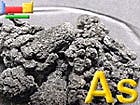Microbial processes ultimately determine whether arsenic builds to dangerous levels in groundwater, say researchers at the University of Illinois at Urbana-Champaign. Remediation may be as simple as stimulating certain microbes to grow.
Arsenic contamination is a serious threat to human health. In the Ganges Delta of Bangladesh, for example, chronic exposure to arsenic has been linked to serious medical conditions, including hypertension, cardiovascular disease and a variety of cancers.
"The threat extends to Central Illinois, where there are very high levels of arsenic contamination in a number of wells," said Craig Bethke, a professor of geology at Illinois and corresponding author of a paper to appear in the November issue of the journal Geology. "We also discovered important links between the amount of organic material dissolved in the groundwater and the concentrations of sulfate and arsenic."
The researchers analyzed water from 21 wells at various depths in the Mahomet aquifer, a regional water supply for Central Illinois. "The Mahomet aquifer was produced by a glacier, which pulverized and homogenized the sediments," Bethke said. "As a result, arsenic sources that leach into the groundwater are pretty uniformly distributed."
Surprisingly, however, arsenic concentration varied strongly from well to well, Bethke said. "Concentrations may reach hundreds of micrograms per liter in one well – which is enough to make people very sick – but fall below detection limits in a nearby well."
The concentration of arsenic varied inversely with the concentration of sulfate, the researchers found. Methane concentration also varied with the sulfate content. "We believe this reflects the distribution of microbial populations in the aquifer system," said graduate student Matthew Kirk. "Our analyses suggest the aquifer is divided into zones of mixed microbial activity, some dominated by sulfate-reducing bacteria, others by methanogens." Sulfate-reducing bacteria will consume sulfate and reduce it into sulfide. The sulfide then reacts to precipitate arsenic, leaving little in solution.
If the sulfate-reducing bacteria run out of sulfate, methanogenic bacteria take over as the dominant metabolic force, Kirk said. Because methanogenic bacteria don't produce sulfide, there is no precipitation pathway for the arsenic, which then accumulates to high levels in the groundwater.
"In the Mahomet aquifer, the balance between the amount of organic material and the amount of sulfate that leaches into the groundwater appears to control whether the water becomes contaminated," Kirk said. "Where the supply of sulfate is high relative to organic matter, sulfate remains available and sulfate-reducing bacteria keep arsenic levels low. But, where the supply of organic matter is high relative to sulfate, the sulfate has been depleted, and arsenic may accumulate."
The researchers' findings suggest that groundwater contaminated with arsenic might be easily identified and remediated.
"Unlike detecting the presence of arsenic — which generally requires a sensitive laboratory analysis — testing for sulfate is simple and straightforward," Bethke said. "If all waters containing sulfate are safe, as in our dataset, then measuring sulfate level would be an easy but reliable field test to identify safe drinking water from unsafe."
Adding sulfate to naturally contaminated groundwater might be a simple but effective method to sequester the arsenic, Kirk said. "The bacteria are already present, so all you have to do is stimulate them." Sulfate salts, he said, are inexpensive, readily soluble and easily obtained.
In addition to Bethke and Kirk, the team included UI geology professor Bruce Fouke, research scientist Robert Sanford, graduate students Jungho Park and Gusheng Jin, and Illinois State Water Survey project scientist Thomas Holm. The U.S. Department of Energy funded the work.
Source: University of Illinois at Urbana-Champaign


